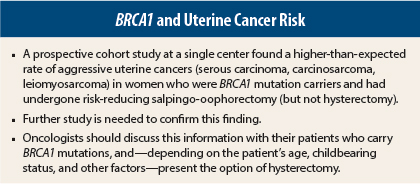Prophylactic surgery to remove the ovaries and fallopian tubes is advised for women who carry BRCA mutations to reduce the risk of breast and ovarian cancer. This procedure, referred to as risk-reducing salpingo-oophorectomy, typically does not require a hysterectomy. However, a new study presented at the Society of Gynecologic Oncology (SGO) Annual Meeting on Women’s Cancer suggests that including a hysterectomy as part of prophylactic surgery may be advisable in women with BRCA1 mutations. The meeting was held March 22–25 in Tampa, Florida.
In the study, women with BRCA1 mutations who underwent risk-reducing salpingo-oophorectomy (but not a hysterectomy) were at increased risk of developing rare, aggressive uterine cancers over the following 10 years. No increased risk was observed for the more common types of uterine cancer in women who had salpingo-oophorectomy and no hysterectomy, and women who were BRCA2 carriers had no increased risk of these rare aggressive cancers.
Key Risk Findings
The study enrolled 525 women with BRCA1 (n = 296) or BRCA2 mutations (n = 226) who underwent salpingo-oophorectomy without a hysterectomy. An aggressive form of uterine cancer (serous
carcinoma, carcinosarcoma, leiomyosarcoma) developed in 4 of the 296 women with a BRCA1 mutation, translating to a 2.1% risk of developing this type of cancer over 10 years.
This risk is approximately 26-fold higher than what one would expect in the general population, said senior author Noah D. Kauff, MD, Director of Ovarian Cancer Screening and Prevention on the Gynecology Service at Memorial Sloan Kettering Cancer Center, New York. Catherine Shu, MD, a fellow at Memorial Sloan Kettering, was lead author.
The current National Comprehensive Cancer Network (NCCN) recommendation is that women with a BRCA1 mutation undergo risk-reducing salpingo-oophorectomy between the ages of 35 and 40 after childbearing is complete. Hysterectomy is not included in the current recommendations, because this procedure carries both short- and long-term risks. Also, it has been assumed that uterine cancers that develop following risk-reducing salpingo-oophorectomy were likely to be low risk, but the new study throws that assumption into question.
“While the absolute risk of aggressive uterine cancer is still relatively low in BRCA1 carriers who did not have a hysterectomy, it is much higher than we would have expected. Doctors should discuss these findings with their patients with BRCA1 mutations who are considering risk-reducing salpingo-oophorectomy. They may decide to opt for a hysterectomy as well. However, the decision to undertake a hysterectomy in addition to salpingo-oophorectomy depends on several factors, including the woman’s age, prior history of cancer, and childbearing status,” Dr. Kauff said.
Study Data
The prospective cohort study was conducted from June 1, 1995, to December 31, 2011. After undergoing risk-reducing salpingo-oophorectomy with the uterus left in situ, 525 women were followed prospectively via annual questionnaires and medical record review for a median of 5.8 years (range, 0.1–16.9 years).
During 3,292 woman-years of follow-up, four high-risk uterine cancers were diagnosed (two serous carcinomas, one carcinosarcoma, and one leiomyosarcoma) at 1.4 to 12.9 years following salpingo-oophorectomy, and no woman developed a low-risk uterine cancer. Of the four cancers, one developed in 168 women with no prior history of breast cancer, and three developed in 357 women with prior breast cancer; two developed in women with a history of tamoxifen use, and two developed in women who had not taken tamoxifen.
“While both a previous history of breast cancer and tamoxifen use have been associated with an increased risk of aggressive uterine cancer, the risk of magnitude that has been reported for these exposures is unlikely to fully explain our findings,” Dr. Kauff stated.
Hypothesis-Generating
According to Thomas Herzog, MD, Director of Gynecologic Oncology at Columbia University Medical Center in New York, this abstract presents important information, but the findings are “not ready for prime-time” application.
“This late-breaking abstract was very interesting in that the type of surgery required when a patient is diagnosed with a BRCA mutation requires careful consideration. Kauff et al have raised an important consideration regarding the role of uterine removal. The data are hypothesis-generating but not confirmatory of an increased risk of uterine cancer for these gene carriers.”
Dr. Herzog said that a larger validation trial is required prior to making hysterectomy a standard recommendation for women who are BRCA mutation carriers.
“These data should be considered in counseling, but they must be weighed against the increased morbidity, cost, and inconvenience of a hysterectomy vs outpatient management, especially considering the low absolute risk of developing uterine cancer for these patients,” Dr. Herzog emphasized. ■
Disclosure: Dr. Kauff has consulted and provided expert testimony for Pfizer.
Reference
1. Shu CA, Pike M, Jotwani AR, et al: Risk of developing uterine corpus cancer following risk-reducing salpingo-oophorectomy in women with BRCA mutations. SGO Annual Meeting on Women’s Cancer. Late-Breaking Abstract 5. Presented March 24, 2014.





